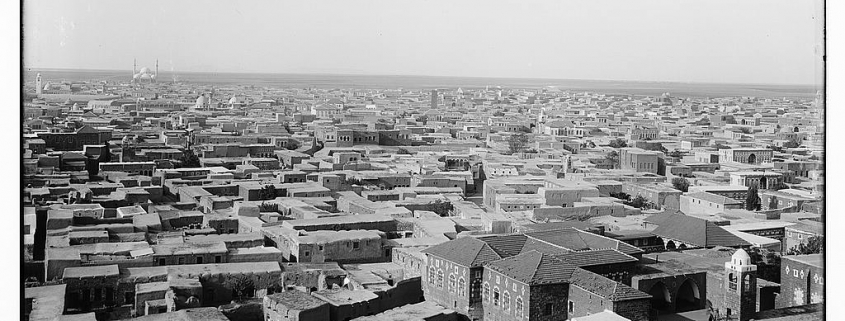On The Road with C. E. S. Palmer
Dimashq Blog | Fadi Esber
In her 1937 book ‘The Syrian Deseret: Caravans, Travel and Exploration’, Christina Phelps Grant described an ‘experimental trip’ between Damascus and Baghdad undertaken by a group of interested individuals. These included Mohammed al-Bassam, a wealthy Baghdad merchant, Major D. McCallum, the British liaison officer with the French Haut-Commissariat in Beirut and C. E. S. Palmer, the British consul in Damascus. Norman Nairn, of the Nairn Transport Company of Palestine and Syria, had loaned them cars and the services of the company’s chief engineer-mechanic, Edward Lovell. The expedition set off from Syria trying to find the shortest route from al-Dumayr (northeast of Damascus) to Ramadi (in Iraq’s Anbar province). On 2 April 1923, Palmer and his party set out in three cars: a Buick, an Oldsmobile and a Lancia. Within three days, they managed to cross a 1000 miles, reaching Ramadi.
After a week’s rest, Palmer ventured back to Damascus. While Grant had described the outward journey Palmer’s party undertook to Baghdad in her book, a detailed report dispatched by the British diplomat upon his arrival in Damascus to the Foreign Office, found in the UK’s Public Records Office, described in meticulous detail the journey back to Damascus, then capital of the Federation of the Autonomous States of Syria (1922-1924).
The journey from Palmyra to Homs took almost four hours, during which Palmer passed by three small villages. Neither the road nor the small settlements offered the consul ‘anything of interest’. Palmer then rested for an hour in a Bedouin tent, at an encampment set up by the Amur clan, before continuing his journey, this time heading towards Hama. A detour near the town of Talbiseh, midway between Homs and Hama, was necessary after flood-water had submerged the road.
Palmer was astonished by the ‘high cost of rentals’, and decided to drive back to Homs. This time around, his car got stuck in the muddy roads around Talbiseh. But Palmer needed not to worry much, as ‘natives were produced from the village and the car was, with difficulty, dragged out’.
As Palmer and his company entered Homs, he noticed that all shops had been closed in protest against the French mandatory authorities, and the people were out on the streets for a ‘mild demonstration’. Under these circumstances, Palmer ‘did not consider it twice’ to remain, in case the French ‘got some foolish idea’ that the coincidence of his arrival and of these demonstrations was not a pure accident. A visit to Homs had to be postponed to another, less suspicious, occasion.
Palmer set off to Damascus early the next day. His explorations were, however, not yet over. Taking an unusual route, he visited the town of Sadad, a sleepy village on the western edge of the Syrian Desert, populated by Orthodox Syriacs. Down the road from Sadad was Hafar, another Syriac village of 800 inhabitants. Not long ago, the people of Hafar were also Orthodox Syriacs, until the entire village was converted to protestantism by a Danish Lutheran Missionary. Since then, Palmer noted, Hafar had only been visited ‘2 or 3 times’ by Europeans other than missionaries. The town possessed a ‘good school where English is taught’, a detail never to be missed by a British diplomat.
From Hafar, Palmer continued south to visit Deir Atyia and al-Nabek, two adjacent towns nestled at the foot of the Qalamoun mountains. There, Palmer found another Danish Lutheran mission and hospital. From al-Nabek, he continued to Yabroud, with the idea of reaching Damascus via Saidnaya, a town with a famous monastery built by the legendary Byzantine emperor Justinian. The road to Saidnaya, to Palmer’s dismay, was impassible, and he had to turn back to al-Nabek; from there he proceeded to al-Quteifa, then Adra, and thence on to Damascus.
Palmer concluded the report by referring to the ‘economic opportunities’ he discovered on his journey.
In Hama and Homs, Palmer found ‘very good quality’ silk goods, mostly produced in Homs and sold on the markets of both cities. He noticed the presence of looms in many houses; while vegetable dyes were once common, synthetic aniline dyes had crept in. The British diplomat also found coarse cotton material that reminded him of those produced in the factories Manchester. Syrian villagers, naturally, preferred home products to those manufactured in the north of England; Palmer, however, saw an opportunity to sell textiles produced in Homs in Europeans markets.
Palmer finished his report with a simple, yet cynical, suggestion. He could forward a sample of the favourite pattern of home-made printed cotton ‘worn by the natives’ in order to help English producers copy it. The copies could then be exported back to Syria to compete with ‘native industry’ for a share of the market. Palmer, nonetheless, concluded with a hollow warning that the export of English textile into the Syrian market ‘might lead to the “death” of a native industry’.
Fadi Esber is the editor of Dimashq Journal
Follow us on Twitter @DimashqJounral
Sources:
- FO 371/9054, Visit of Mr. Palmer to Homs and Hamah, Palmer (Damascus Consul) to FO, E. 6099, 25 May 1923.
- Phelps Grant, Christina. The Syrian Deseret: Caravans, Travel and Exploration. London, 1937.
Image:Homs in the early 20th century (Library of Congress).



